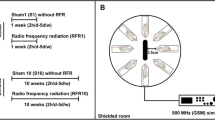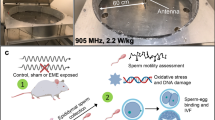Abstract
This work analyzes the effects of radiofrequency-electromagnetic field (RF-EMF) exposure on the reproductive system of male rats, assessed by measuring circulating levels of FSH, LH, inhibin B, activin B, prolactin, and testosterone. Twenty adult male Sprague–Dawley rats (180 ± 10 g) were exposed to 900 MHz RF-EMF in four equal separated groups. The duration of exposure was 1, 2, and 4 h/day over a period of 30 days and sham-exposed animals were kept under the same environmental conditions as the exposed group except with no RF-EMF exposure. Before the exposure, at 15 and 30 days of exposure, determination of the abovementioned hormone levels was performed using ELISA. At the end of the experiment, FSH and LH values of the long time exposure (LTE) group were significantly higher than the sham-exposed group (p < 0.05). Serum activin B and prolactin in the LTE group showed significant increase and inhibin B showed significant decrease than sham and short time exposed (STE) groups after 30 days RF-EMF exposure (p < 0.05). Also, a significant decrease in serum testosterone levels in the LTE group was found compared to short and moderate time exposed (MTE) groups after 30 days RF-EMF exposure (p < 0.05). Results suggest that reproductive hormone levels are disturbed as a result of RF-EMF exposure and it may possibly affect reproductive functions. However, testosterone and inhibin B concentrations as a fertility marker and spermatogenesis were decreased significantly.



Similar content being viewed by others
References
Agarwal A, Desai NR, Makker K, Varghese A, Mouradi R, Sabanegh E, Sharma R (2009) Effects of radiofrequency electromagnetic waves (RF-EMW) from cellular phones on human ejaculated semen: an in vitro pilot study. Fertil Steril 92(4):1318–1325
Aitken R, Bennetts L, Sawyer D, Wiklendt A, King B (2005) Impact of radiofrequency electromagnetic radiation on DNA integrity in the male germline. Int J Androl 28(3):171–179
Barakat B, O’Connor AE, Gold E, de Kretser DM, Loveland KL (2008) Inhibin, activin, follistatin, and FSH serum levels and testicular production are highly modulated during the first spermatogenic wave in mice. Reprod 136(3):345–359
Bergmann M, Behre HM, Nieschlag E (1994) Serum FSH and testicular morphology in male infertility. Clin Endocrinol 40(1):133–136
Celik S, Aridogan IA, Izol V, Erdogan S, Polat S, Doran S (2012) An evaluation of the effects of long-term cell phone use on the testes via light and electron microscope analysis. Urology 79(2):346–350
de Kretser DM, Loveland KL, Meehan T, O’Bryan MK, Phillips DJ, Wreford NG (2001) Inhibins, activins, and follistatin: actions on the testis. Mol Cell Endocrinol 180(1):87–92
De Rosa M, Zarrilli S, Di Sarno A, Milano N, Gaccione M, Boggia B, Lombardi G, Colao A (2003) Hyperprolactinemia in men. Endocrine 20(1–2):75–82
de Seze R, Fabbro‐Peray P, Miro L (1998) GSM radiocellular telephones do not disturb the secretion of antepituitary hormones in humans. Bioelectromagnetics 19(5):271–278
Deepinder F, Makker K, Agarwal A (2007) Cell phones and male infertility: dissecting the relationship. Reprod Biomed Online 15(3):266–270
Desai NR, Kesari KK, Agarwal A (2009) Pathophysiology of cell phone radiation: oxidative stress and carcinogenesis with focus on male reproductive system. Reprod Biol Endocrinol 7(14):114–122
Dufau ML (1988) Endocrine regulation and communicating functions of the Leydig cell. Annu Rev Physiol 50(1):483–508
Esquifino AI, Chacon F, Jimenez V, Toso CFR, Cardinali DP (2004) 24-h changes in circulating prolactin, follicle-stimulating hormone, luteinizing hormone, and testosterone in male rats subjected to social isolation. J Circadian Rhythms 2(1):1
Foppiani L, Schlatt S, Simoni M, Weinbauer G, Hacker-Klom U, Nieschlag E (1999) Inhibin B is a more sensitive marker of spermatogenetic damage than FSH in the irradiated non-human primate model. J Endocrinol 162(3):393–400
Forgacs Z, Somosy Z, Kubinyi G, Sinay H, Bakos J, Thuroczy G, Surjan A, Hudak A, Olajos F, Lazar P (2004) Effects of whole-body 50-Hz magnetic field exposure on mouse Leydig cells. Sci World J 4:83–90
Forgacs Z, Somosy Z, Kubinyi G, Bakos J, Hudak A, Surjan A, Thuroczy G (2006) Effect of whole-body 1,800 MHz GSM-like microwave exposure on testicular steroidogenesis and histology in mice. Reprod Toxicol 22(1):111–117
Gona AG, Yu MC, Gona O, Al-Rabiai S, Von Hagen S, Cohen E (1993) Effect of 60 Hz electric and magnetic fields on the development of the rat cerebellum. Bioelectromagnetics 14:433–447
Iorio R, Scrimaglio R, Rantucci E, Delle Monache S, Di Gaetano A, Finetti N, Francavilla F, Santucci R, Tettamanti E, Colonna R (2007) A preliminary study of oscillating electromagnetic field effects on human spermatozoon motility. Bioelectromagnetics 28:72–75
Karadede B, Akdag MZ, Kanay Z, Bozbiyik A (2009) The effect of 900 MHz radiofrequency (RF) radiation on some hormonal and biochemical parameters in rabbits. J Int Dent Med Res 2(3):110–115
Leszczynski D, Nylund R, Joenvaara S, Reivinen J (2004) Applicability of discovery science approach to determine biological effects of mobile phone radiation. Proteomics 4(2):426–431
Mann K, Roschke J (1996) Effects of pulsed high-frequency electromagnetic fields on human sleep. Neuropsychobiol 33:41–47
Masamichi K (2006) Electromagnetics in Biology. Springer
Meo SA, Al-Drees AM, Husain S, Khan MM, Imran MB (2010) Effects of mobile phone radiation on serum testosterone in Wistar albino rats. Saudi Med J 30(8):869–873
Mostafa RM, El Hefnawi A, Moustafa K, Ali F, Moustafa Y, Kamal S, El Hefnawi M (2007) Effect of 50 Hz, 10 mT magnetic field on sex hormones level in male rats. J Med Sci Res 1:31–36
Pierik FH, Vreeburg JT, Stijnen T, de Jong FH, Weber RF (1998) Serum inhibin B as a marker of spermatogenesis. J Clin Endocrinol Metab 83(9):3110–3114
Sarookhani M, Rezaei MA, Safari A, Zaroushani V, Ziaeiha M (2011) The influence of 950 MHz magnetic field (mobile phone radiation) on sex organ and adrenal functions of male rabbits. Afr J Biochem Res 5(2):65–68
Wdowiak A, Wdowiak L, Wiktor H (2007) Evaluation of the effect of using mobile phones on male fertility. Ann Agric Environ Med 14(1):169–172
Wilson JD (1994) Endocrinology and metabolism. In: Isselbacher KJ (ed) Harrison’s principles of internal medicine, 13th edn. McGraw-Hill, Inc, New York, pp 1883–1888
Xia Y, Schneyer AL (2009) The biology of activin: recent advances in structure, regulation, and function. J Endocrinol 202(1):1–12
Zirkin BR (1998) Spermatogenesis: its regulation by testosterone and by FSH. Semin Cell Dev Biol 9(4):417–421
Acknowledgments
Animals were kindly provided by Dr Mahjoob Vahedi at the Laboratory Animal Center of University of Medical Science, Shiraz, Iran. Hormonal analysis was kindly performed with the cooperation of Professor Saeb Specialized Hormone Laboratory, Shiraz, Iran. Mr. Omid Koohi Hosseinabadi provided expert technical assistance with animal handling and sampling. The authors declare that there is no conflict of interest that would prejudice the impartiality of this scientific work.
Author information
Authors and Affiliations
Corresponding author
Rights and permissions
About this article
Cite this article
Sepehrimanesh, M., Saeb, M., Nazifi, S. et al. Impact of 900 MHz electromagnetic field exposure on main male reproductive hormone levels: a Rattus norvegicus model. Int J Biometeorol 58, 1657–1663 (2014). https://doi.org/10.1007/s00484-013-0771-7
Received:
Revised:
Accepted:
Published:
Issue Date:
DOI: https://doi.org/10.1007/s00484-013-0771-7




